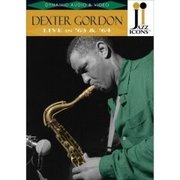What a manly man that Dexter Gordon was. Not that he was macho -- if the tenor-sax gigantor swaggered a little, he also staggered a little.
One reason to pick a fight with Dexter Gordon: You might think you could whip him; his playing bore the deep imprint of the world’s most wonderful wimp, Lester Young, with whom he briefly shared a home city (Los Angeles), and from whom he learned to extract full aroma from a ballad and to add a touch of vibrato at the end of phrases. Two reasons not to pick a fight with Dexter Gordon: 1) You’d rather buy him a drink; 2) He was 6 and a half feet tall.
You will know Dexter Gordon a lot better after seeing this ’63-’64 DVD from Switzerland, Belgium and the Netherlands, the third I’m reviewing from this year’s astounding crop of seven Jazz Icons vids. Like how he talked. If you’ve only heard him in that not-bad 1986 reality-inspired movie “’Round Midnight,” you might think as I did that he always used that stoned guttural whisper. But here he is introducing “What’s New,” and he’s got a voice like a ‘40s radio announcer, all rounded tones and impeccable diction. It’s a parody, of course, same as Charlie Parker’s professorial MC schtick. Now I wonder how he talked to his friends.
Gordon’s summer 1964 show for Dutch TV makes a good lead-in because of the casual drama: It starts by following a trenchcoated Gordon down the street and into a club, where his trio is already playing. He hands coat and hat to the bartender, gets up on the stage and blows. Nice touch.
Gordon never blew stronger than in these years after he got out of prison (second skag bust). The notes come tumbling out of his horn like warm doughnuts, beginning with an uptempo version of “A Night in Tunisia” where Gordon feels as if he’s saying, “Well, this is a little too quick, ain’t it? But I’m not gonna force it, just skip a few notes when they begin to crowd.” His sound by this time contains some Coltrane -- they influenced each other back and forth, and Gordon has adopted that way of overblowing the first note of a phrase and laying out metallic, affectless long tones. But Gordon is far more sensual than Trane; just listen to the sad familiarity of “What’s New.” Women musta heard that and wanted his fingers all over them.
The disc’s early-1964 closing segment hails from Belgian TV, with some good up-close camerawork, sound quality equal to the high Dutch standard, and the same backing trio of pianist George Gruntz, bassist Guy Pedersen and drummer Daniel Humair. These guys are pretty boring, except Humair, who shows why he was the choice of expatriate American jazzbos (including Bud Powell, after whom Gordon’s character in “’Round Midnight” was modeled): He really knows how to bring the kind of supple low-end swing that makes everything easy, as on the big, wide performance of “Lady Bird.”
And when it comes to sidemen, boring isn’t bad; easy does it for Dex. Slightly inferior sound and static photography aren’t the only factors that make the 1963 festival footage from Lugano, Switzerland, the least of the DVD’s valuable finds, despite a combo that includes Kenny Drew on piano and the great Art Taylor on drums. Chalk it up to lack of rehearsal: Drew, Taylor and bassist Gilbert Rovere acted as a house band for the fest. Individually, Drew’s neoclassical harmonies and rippling accompaniment draw the ear, and so does Taylor’s boppish bomb-dropping on the snare and loosely snapped wrist on the ride cymbal. But Gordon, despite a sensitive reading of “You’ve Changed,” doesn’t seem completely relaxed -- it’s not his crew.
A lot of images make this DVD memorable: the horizontal (not vertical) line of concentration between Gordon’s eyes, the light sweat on his brow, his deceptively babylike smile. But I think my favorite thing is his necktie in Holland. Ties were skinny in 1964. Put one on Long Tall Dexter, and it looks as if somebody took a pen and drew a line down his shirt.
Yeah, just try it.

